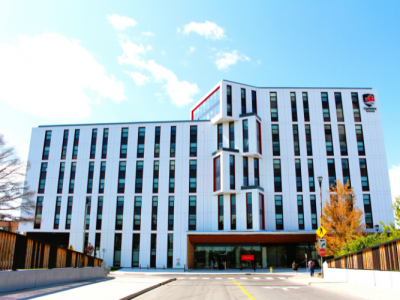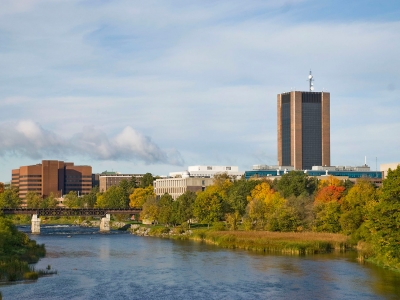Researchers at Carleton University’s Azrieli School of Architecture & Urbanism have developed a design handbook that proposes new ways to enjoy safe outdoor dining in Ottawa during and after pandemic restrictions.
Titled Dinner in the Street: Dining Safely and Socially in the Pandemic City and Beyond, the project aims to help the restaurant industry and enhance public life while maintaining physical distancing for public health. It also looks for opportunities for local food production and better serving the underserved.
“Dinner in the Street is located at the intersection of social health, physical health and economic health, and addresses ways in which providing public venues for dining can serve all three of these goals,” the handbook authors write.
The illustrated 28-page handbook proposes closing select streets to traffic and offers design concepts for five Ottawa neighbourhoods. It also contains ideas for structures, physical distancing strategies, zoning changes, and themes that reinforce neighbourhood identity.
The research was funded by the MITACS Accelerate Grant Program, which opened a special category for COVID-19-related research last year. The researchers were recent master of architecture graduates Shelby Hagerman and Rehab Salama, working under the direction of Jill Stoner, former director of Carleton’s Azrieli School of Architecture & Urbanism.
They studied international precedents for outdoor communal dining and consulted Ottawa community leaders and restaurant owners to develop the following proposals:
- Argyle Avenue in Centretown could be closed for weekly communal feasts for the underserved beneath colourful umbrellas decorated with patterns inspired by flags of the world and Canada’s provinces and territories.
- Daly Avenue in Sandy Hill could be periodically closed for artist-themed benefit dinners, hosted by the Ottawa Art Gallery and food from Daly Avenue restaurants.
- George Street and York Street in the ByWard Market could be permanently closed to traffic, and host large numbers of people dining out in a festive atmosphere. New paving or paint that graphically adds a pattern can help establish physical distancing.
- The cul-de-sacs off Preston Street in Little Italy could reduce the width of their traffic lane and develop community gardens for a farm-to-table experience. Meals can be delivered from Preston Street restaurants.
- One block of Hazel Street in Old Ottawa East could be planted as a wheat field, softening a large nearby housing development edge. Small mowed circles provide an area for physically-distanced tables for solo diners.
Finally, the authors propose a “Winter Street” of cabins and tents that can be set up outside restaurants. They come in three sizes: Date Cabins for two people; Social Cabins for three-to-four people; and Family Cabins for five-to-eight people.
The research is based on the following:
- Many people will continue to work from home, relieving city streets of much daily traffic;
- Even after herd immunity, people will be inclined to maintain greater physical distances between themselves and others;
- This period of crisis will engender a more lasting spirit of collaboration between industry, academic, and policy sectors.
Media Contact
Steven Reid (he/him)
Media Relations Officer
Carleton University
613-265-6613
Steven.Reid3@carleton.ca
Follow us on Twitter: www.twitter.com/Cunewsroom
COVID 19 Updates: https://newsroom.carleton.ca/coronavirus-covid-19/messages/
Monday, August 9, 2021 in News Releases
Share: Twitter, Facebook



